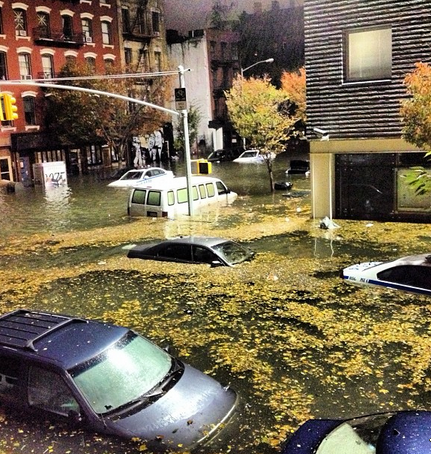
jesseandgregThe East Village after Hurricane Sandy.
Since the 2007 release of PlaNYC, New York City Mayor Michael Bloomberg’s sustainability vision, the city has chipped away steadily at its carbon emissions, cutting them to 13 percent below 2005 levels already. But nothing New York does on its own to mitigate climate change can save the city from future Sandys and the sea-level rise that will make such storms even more destructive going forward.
Last week, Bloomberg unveiled an ambitious, expensive plan to fortify the city against the kind of extreme weather that’s fast becoming the “new normal.” The event amplified a message more local leaders are embracing: Climate change is already upon us, and adapting to it will be essential to prevent massive losses of money and life.
On Monday, the mayors of Washington, D.C., Denver, Nashville, and 42 other U.S. cities signed a “Resilient Communities for America” agreement, pledging “to prepare and protect their communities from the increasing disasters and disruptions fueled by climate change.” According to a press release about the campaign, $1 spent on disaster preparation saves $4 in potential losses (consider that Hurricane Sandy caused almost $20 billion of damage). The local leaders also called for more support and cooperation from the federal government. Although, as Bloomberg himself has pointed out, cities are in an ideal practical position to start taking immediate climate action, the scale of work to be done to strengthen urban infrastructure requires all the federal dollars they can get.
The Associated Press explains how, in green circles, a focus on adaptation was once frowned upon, out of concern that it would distract from efforts to address the source of the problem or downplay its importance. That concern still exists, but as a climate-changed world becomes reality much faster than a global climate solution, government officials figure they’d better prepare for the worst.
Plus, discussions about disaster planning are less polarizing than debates about how to slow down climate change, the AP reports:
Now officials are merging efforts by emergency managers to prepare for natural disasters with those of officials focused on climate change. That greatly lessens the political debate about human-caused global warming, said University of Colorado science and disaster policy professor Roger Pielke Jr. …
“If you keep the discussion focused on impacts … I think it’s pretty easy to get people from all political persuasions,” said Pielke, who often has clashed with environmentalists over global warming.
It’s hard to argue against preparing your town for disaster. That makes adaptation plans easier to agree on than schemes to reduce carbon emissions, for example. But that doesn’t mean adaptation plans are easy to fund.
And sometimes the steps that cities can afford to take are not popular. The AP again:
For poorer cities in the U.S., what makes sense is to buy out property owners, relocate homes and businesses and convert vulnerable sea shores to parks so that when storms hit “it’s not a big deal,” [S. Jeffress Williams, University of Hawaii geophysicist and former sea-level rise expert for the U.S. Geological Survey,] said.
But relocating homeowners does not tend to be a politically palatable solution. From another AP article:
A University of Virginia report released last year that was based on community feedback from [Virginia Beach] city residents said the least socially feasible way of addressing the problem was the purchase of development rights, while the most likely option to help the city prepare for sea level rise was to provide greater education and updated zoning.
Updated zoning could mean new requirements like one under consideration in Norfolk, Va., that would mandate a 20-foot setback from the mean high-water mark for new homes, or one already on the books in Virginia Beach that requires new construction or major expansions to be elevated one foot above base flood levels. Many other seaside cities are encouraging homeowners to put their houses on stilts.
But even struggling cities in the lower 48 have it easier than many more vulnerable communities around the world, where the threat is more urgent but resources to address it are scarcer. Take Newtok, Alaska, which could be entirely underwater by 2017, but where plans to relocate its 63 houses have stalled in the absence of state and federal relocation assistance.
A recent U.N. report emphasized the moral imperative to provide relocation assistance to at-risk communities, according to Reuters:
The report says: “Because the poorest people are already struggling with day-to-day survival, the poorest countries will face more difficulties as they attempt to overcome the damage done by climate change — flood, storm, rainfall, weather-related illnesses — and to find ways to adapt themselves”.
Read more from the AP about what cities around the world are doing to prepare for climate change. Whatever strategies communities adopt, one thing is certain: There’s no time to waste.




